Viewing time period – 21:19 – 23:23
Slewed Tak to M53 started to take colour frames. Clouded up around 11pm so shut dome and took darks, flats and flat darks.

Viewing time period – 21:19 – 23:23
Slewed Tak to M53 started to take colour frames. Clouded up around 11pm so shut dome and took darks, flats and flat darks.

Viewing time period – 18:16 – 23:15
Here is my workflow so I can repeat each night until this is finished.
Open dome – done
cool down – done
turn off dehumidifier – done
turn off fans on scope – done
find home – done
focus – done 60,535 clear
remove existing model – done
slew and sync to nearby star – done
make sure scale is correct -done
make sure image link to all sky database is selected – done
start TPoint run – done @ 21:13
Complete TPoint – 93 points done, paused TPointing at 23:15
Turn on Dehumidifer – done
Note that tonight I found the dome was definitely not lining up with the 12″ OTA. We have noticed this gradually becoming as problem over the past weeks and months. I am not sure if this is a problem with software, hardware, a change in settings or the temperature of the dome in some way has effected this. To this end I will set about a calibration run of the dome tomorrow to see if that can rectify the issue.
Viewing time period – 20:59 – 23:42
Here is my workflow so I can repeat each night until this is finished.
Open dome – done
cool down – done
turn off dehumidifier – done
turn off fans on scope – done
find home – not needed
focus – done 59,659 clear – done

slew and sync to nearby star – done at 21:06 as not dark enough before then

make sure scale is correct -done
make sure image link to all sky database is selected – done
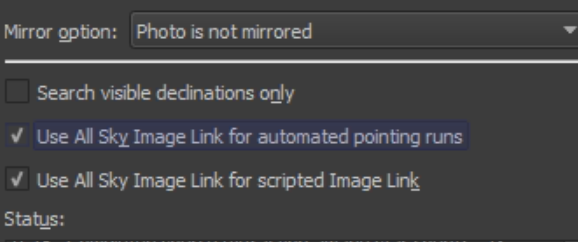
start TPoint run at point 93 – done @ 21:10
Complete TPoint – 231 points done at 23:46 including checking 5min unguided exposure which was fine

Turn on Dehumidifer – done
So what did I learn tonight? It was worth doing the TPoint model. The resulting pointing accuracy is much better with objects being almost centre off the chip. Unguided images on the 12″ look good at 5mins, I will try longer when the clouds and rain disappear. That following a documented approach helps as above. The adjustments to the worm and the loose weight helped. That fixing the dome rotation slippage on the encoder today helped.


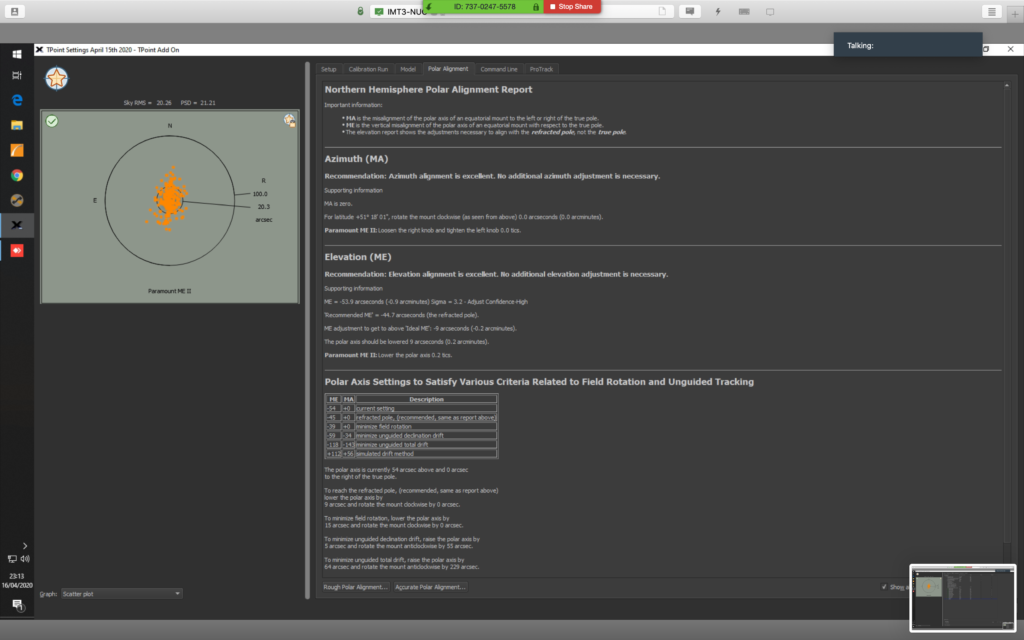





I mentioned above the dome slipping on the encoder, this was because of the small weak spring that is used on the dome, which is not good enough and over the past year has stretched beyond its limit. This means as the dome rotates and the dome shudders due to the joins in the dome not being flush (another issue) and thus the spring is stretched. This meant that some of the time the encoder wheel seen below was not touching the dome and therefore lost around 30-40 degrees. To rectify I have temporarily stretched and tightened the spring which we will replace later with a more suitable one.


Viewing time period – 20:30 – 22:30
Tried again to get the TPoint completed tonight but hit with a load of issues which I will try to sort tomorrow. FoV in TSX was wrong. Not plate solving in TSX. Focus potentially an issue. Use of All Sky Image Link for Scripted Image Link needed to be selected from the Image Link –> All Sky tab. Image scale in various places was incorrect again and should be 0.32. Managed to get to 10 points with 3 failed. Clearly something has changed given this worked a week ago. I will attempt a go tomorrow night to resolve. Meanwhile I have left Bob to image. In hindsight we should also be leaving the observatory running all night as when I got up at 4am it was crystal clear and dome was closed as nothing planned, so a default object and scope setting should be used and left running. However, Bob did manage to grab some frames in the clear of M53 until what looks like 3am so that is better than nothing.
Viewing time period – 20:32 – 22:13
Dome has been open a few hours now and the 12″ cooling down with the fans on.
At first the TPoint run was not solving the image, I had to change again the Image scale which was set to 0.01 for the automated TPointing back to 0.32.
Once this was done I started a new TPoint run. The new numbers coming in looked better on the scatter graph, however at about 29 points the mount stalled and the TPoint stopped. So I went out and backed off, turning anti-clockwise the spring screws 1/8 turn on the RA axis. I then restarted the mount, but now it is too late to start again as I have work tomorrow. So I will leave the mount in Bob’s capable hands and head off to bed.
Viewing time period – 21:02 – 04:21
Started TPointing at Point 153, at 22:00 got to Point 231 which gave us 192 confirmed points.
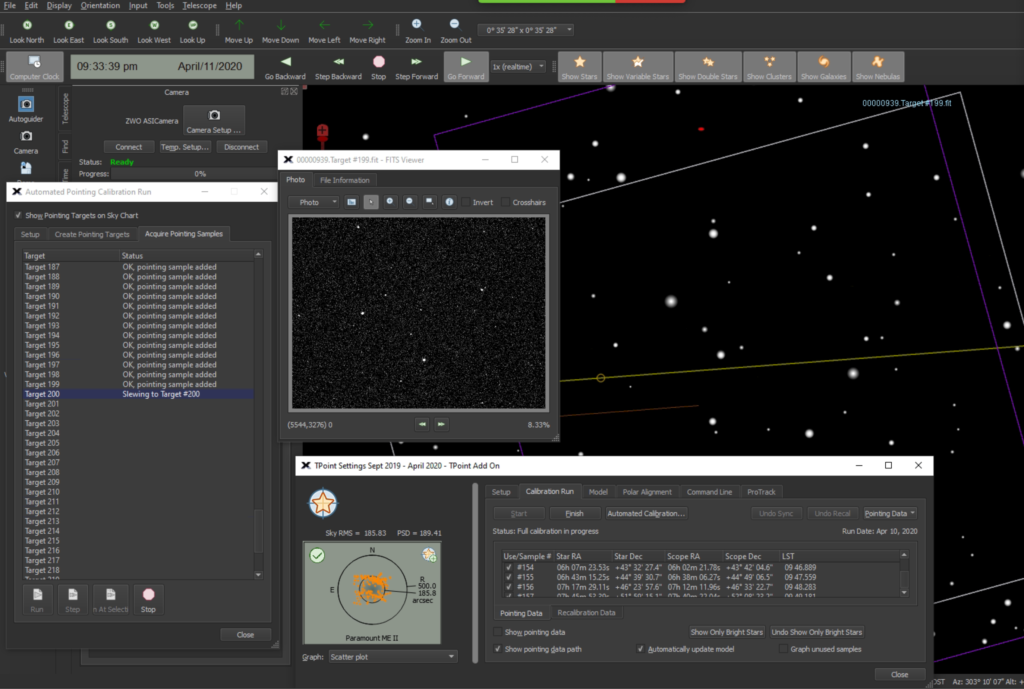
Then went back and did the following points
Point 28 (DONE)
Point 50-55 (DONE)
Point 60 (DONE)
71-92 (DONE)
100-153
101-106 (DONE)
Failed – 107, 108, 112, 113, 130-132,134
Not tried – 100,109-110, 114-118
Completed – 111, 119-129,133,135-152
We had some cloud around 22:45 until 23:29
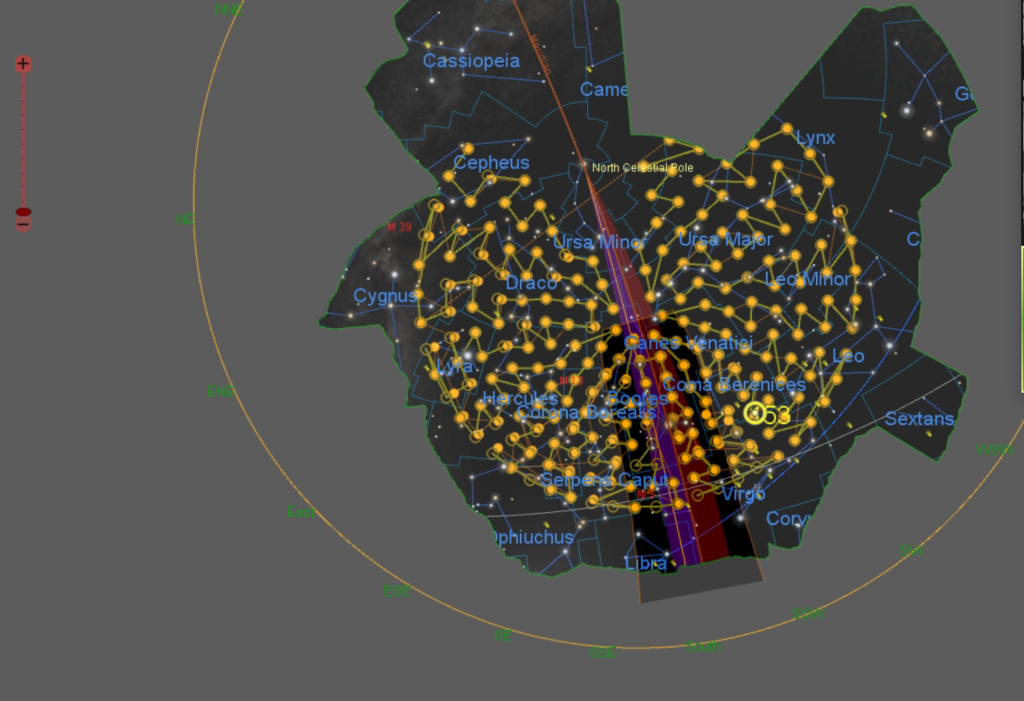
Throughout this time I processed some Lunar images on the Windows laptop with AutoStakkert from the previous few nights of imaging through the Mak 180. I have noticed you cannot open anything larger than 4GB file size !!

@1:52am TPoint finished
@2:09 GingerGeek took over to look at focuser positions and backlash and autofocus on the Takahashi FSQ102.
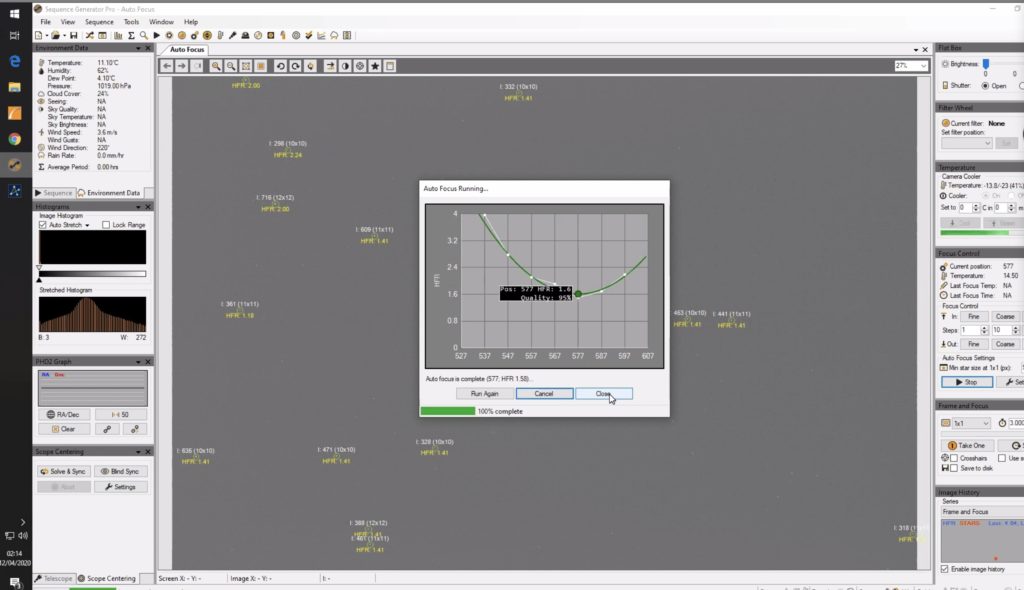
Then we started to image M53 on the Tak for RGB data to add to the Luminance data we already have from GingerGeek’s data on the Esprit 120ED.

Tomorrow I will need to look at the TPoint model to refine it!
Addendum ……
So I took a look at the TPoint model and could not get it below 109 inner circle and 200 outer circle without removing a lot of points. So I posted question on the Bisque Sky X forum.

They came back and stated there is something loose in my imaging train or the mount. There is nothing wrong with my imaging train so instead I performed adjustments on the worm gear as they suggested. I will now need to re-TPoint to see if this makes a difference.


Viewing time period – 20:36 – 00:33
Another night of trying to complete a TPoint run. After opening the dome around 4pm to cool down and turning the fans on the 12″ and pulling back the light shield material we (Bob, GingerGeek and I) @20:49 completed Slew and Sync to test plate solving ability which worked well.

We then started the TPoint run.


Our first failure was Point 28 @21:21. The following are other failures.
Failed Point 50,51,52,53 @21:42
Failed Point 55 @21:45
Failed Point 60 @21:53
Failed Point 71,76,77,78,79,80,81,84,85,86,89,

We then performed the first of a few meridian flips back and forth at Point 92

At pointing sample 96 we changed from 20s exp to 25s (20 failed at this point) to see if this helped the failure rate, it helped a little. The sky clarity was not great nor was the 12″ pointing correctly through the dome at the Meridian so need to look at this at a future point.
More Tpoints failed as follows. TPoint 100,102,105,106,107 (at this point scope 1/3 obscured by slit!)

Failed TPoint 109,110,112,113,114,116
By 11pm after 2 hour we had completed 122 points
Failed TPoint 123,127,128,129,130,131,132,133,134,135
@23:39 stopped due to cloud
@00:33 stopped again due to cloud and shut dome but left TPoint session unfinished to see if we can pick up tomorrow night if clear.
Viewing time period – 20:54 – 22:30

Tonight I set out to perform a TPoint run to improve the values we got last October. However it transpired to be more difficult than I thought. We updated TSX after October to there latest release, this seemed to have changed some of the parameters for plate solving. This meant that every time we took an image in the TSX it would not plate solve and so we could not perform the TPoint run. After the best part of 1 hour I gave up and let Bob take over the scope to play.
Meanwhile I then setup the Mac 180 to image Venus, however, by the time I got round to it and found it in the telescope and thus on the chip it was low down the side of the house opposite by the roof and was bumping around badly due to thermals. I found it difficult to centre the scope on Venus with such a small chip so I may need a more repeatable way of doing this moving forwards. I took a couple of videos just for posterity even though I felt the quality would be poor.
Subsequently the following day I opened up the images take with TSX and also download the All Sky Database that was missing to both the NUC in the dome and my local Mac. I then started to change the settings in Image Link within TSX until I could solve the image.

The key parameter transpired to be the Image Scale Tolerance on the All Sky tab setting it to 5% from 1%. Also I changed the Image Scale back to 0.32. On the Setup tab I selected Setup under Source Extraction and changed the detection to 10.0 and the minimum number of pixels to 20.0.

I then tried a second image and that solved in 1 sec too so very happy. I will try to give the TPoint another go tonight as well as Venus on the Mac 180. If TPoint works I will take RGB on the Tak. First solution from the image I solved can be seen below.

The resulting astrometric solution from TSX is below based on another 60s exposure image is below as text.
******* ASTROMETRIC SOLUTION RESULTS ******** Center RA (2000.0): 07h 14m 12.34s Center Dec (2000.0): +32° 34' 16.1" Scale: 0.3250 arcseconds/pixel Size (pixels): 4656 x 3520 Angular Size: 0° 25' 13" x 0° 19' 04" Position Angle: 195° 28' from north through east Mirror Image: No RMS: 0.88 (X: 0.45 Y: 0.75) Number of Stars Used in Solution: 40 (100%) FWHM: 8.98 pixels, 2.92 arcseconds ***********************************************
Things still to resolve
Viewing time period – 18:42 – 04:21

Hoping to perform a TPoint run tonight, along with gathering some frames on M53 through all 3 scopes (along with Darks and Flats for the Esprit), as we only got some frames through the Tak yesterday. I also hope to try out the Mak 180 Sky-Watcher on the portable mount at the same time from the garden. I will also join the BAS Zoom meeting with all the rest of the gang on as we go through the night, which we have been doing for the past 11 days due to this unprecedented lockdown of society globally due to the Coronavirus, Covid-19 SARS-Coronavirus2 outbreak.
So progressed well tonight, spent the whole night on Zoom with the other astronomers so good company. Managed to image the following Lunar 100 objects, L13 – L30 – L42 – L53 – L59 – L65 – L68 as well as Venus which was at a phase of 44.75%.
@23:53 finished imaging with the Mak 180
Unfortunately M35 has now set and Bob is still imaging the Moon so I will have to grab M35 tomorrow early if it is clear……
I saw big problems with calibration with PHD2 which need to be looked at on the Tak.
@4:21am went to bed whilst the IMT3 was taking Darks
Things to still resolve
Viewing time period – 18:56 – 00:59
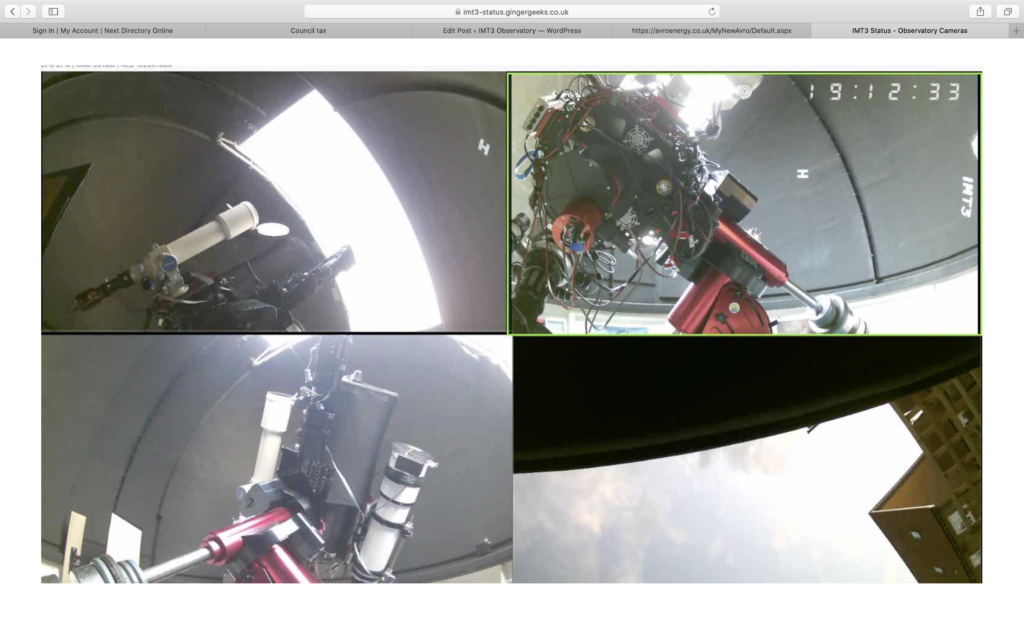
So early on as always I opened the dome to cool down. Tonight Bob, Gingergeek and I want to image Venus in the Pleiades. Even before it got dark and as I slewed the telescopes to Venus, it was visible straight away so I took a quick image, 0.001s from both the 12″ and Bob’s FS102.
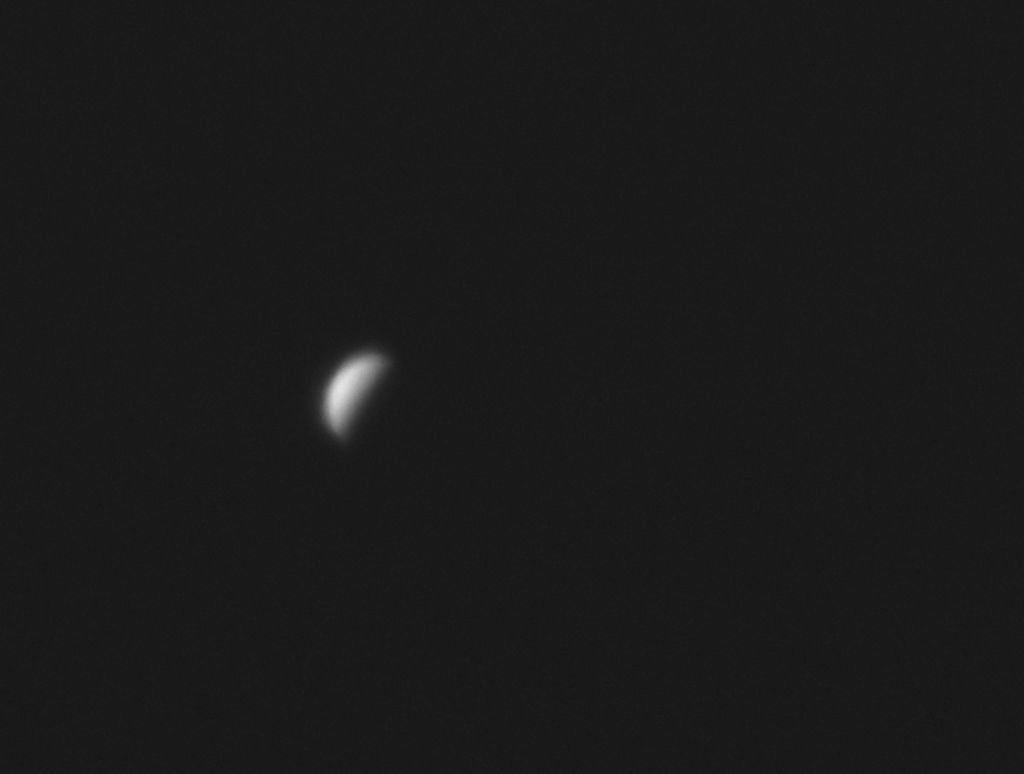

I then went off to watch TV with Helen whilst Gingergeek and Bob grabbed some more images of Venus.
Around 10pm I re-joined Bob and GingerGeek and we set about imaging Venus as it passed by M45 Pleiades in the Tak FS 102. We then went on to perform autofocus on the Tak followed buy setting up the autofocus on the Esprit 120ED
Before the clouds decided to put a stop to play, we took some images of M53 the globular cluster on the Esprit around 00:10am using the Luminance filter.

By 00:59 the clouds finished play 🙁
Viewing time period – 20:30 – 22:20
Tonight GingerGeek, Bob and I wanted to make sure the newly installed version update for SGPro was working. In particular we wanted to get the sync and solve working, so that we could centre an object, but also the autofocus as the was a major update.













The mount in TSX and SGPro are now synced to the correct position in the sky.
Viewing time period – 17:18 – 02:07
Cooling down telescope ready for tonights viewing

M94 and NGC 3395/3396 are the 2 targets for tonight, some luminance on M94 and RGB on NGC 3395/3396 if I get enough time. I always try to open the dome early to give at least 2-4 hours cooling before I use.

When I was about to start with autofocus I tried to recenter back on the target but the mount respond and it transpired that the mount thought it was out of balance. I went to the dome and the mount was beeping proving it was out of balance. So I turned the mount off, manually moved the scopes pack to the park position and then turned the mount back on and all was well.
@19:57 I performed the autofocus for the night on Luminance which scammer in at a position of 75282 on the focuser.

@20:10 I started an imaging run of 24 x NGC 3395/3396 with Luminance filter. Once done I planned on grabbing RGB frames before moving on to M94.

@22:32 I started on the RGB frames for NGC 3395/3396 after refocusing on the Red filter.

@1:40 I slewed to M94 and changed the filter to Luminance. I performed a refocus and shifted from 77895 to 75884 on Red filter by accident. So we (I had Bob on Zoom by this point) refocused on the Luminance and the new focus position was 74884. So the difference is 1000 for Luminance to Red. I also changed the step size for the focuser temperature compensation from 531 to 431 to see if the HFR is more stable.

I noticed tonight that PHD2 lost the Use Direct Guide check mark twice and thus complained about pulse guide not being supported. I had to stop guiding, disconnect the mount in PHD2 and go into the settings, check the Use Direct Guide and reconnect the mount and start guiding again. Something to look into possibly.

@02:07 I went to bed and left the scope gathering another 2 hours of Luminance data on M94.
Addendum …….
The following day I took the ZWO ASI1600MM CMOS Camera off the back of the 12″ and cleaned the sensor window. What I found was the dark dust doughnuts disappeared and the rest for the doughnuts were actually on the filters.




Things to still resolve……..
Viewing time period – 19:15 – 23:05
As I found last night I need to get Temperature Compensation working for the focuser if I am to produce any decent images. SGPro has a Temperature Compensation Trainer which I will follow.

I started @19:35 by taking an image of a star field to make sure there were no bright stars and then ran the autofocus routine. This came back with a focus position of 76974 at 11.5℃.

Next I started the Temperature Compensation wizard which seems to measure the difference in focus position over a 5℃ decrease in temperature. It takes the initial reading above and then you wait until the temperature has dropped by 5℃.

It took 3.5 hours for the temperature to drop by 5℃. So @23:08 I then ran the autofocus routine and got the next image and result. This resulted in 531 steps per 1℃ of temperature change.

Viewing time period – 18:16 – 01:43

Tonight I plan on setting the 12″ imaging M94, a Messier galaxy in Canes Venatici.
I slewed to nearby star and focused using SGPro after changing a couple of settings in the step size and amount of data points to be used, I set step size to 100 from previous 1000 and data point to 5 from previous 10 and got a much better focus. Focus landed up first time around at 738840

I had tried to get @focus working in TSX but it would fail every time on the galaxy with not enough stars. This meant I could not use TSX to solve and sync to centre M94.

I then tried to centre with SGPro and that also failed so instead I used TSX to connect to the camera and manually moved M94 to the centre of the chip. I ned to get the local plate solver working as it was not running.
@ 20:32 I took an initial 5min sub to see what the image would be like after setting PHD2 guiding running.

@1:20 and after gathering 3 hours of data I moved to other side of mount so meridian flip. I refocused as it had drifted a lot. I now need to consider setting up focus move for temp as the focus shift is dramatic. I also changed PHD2 Hysteresis setting to 0.20 from 0.10 as the PHD was having problems guiding.
I struggled to find guide star and landed up exposing for 15s and then having to increase, possibly needs recalibrating on this side of the mount. But also I need to find a brighter guide star by moving the mount offsetting the galaxy. The other way is using one of the piggy backed scopes which I may do next time.
@1:43 the dome closed, not sure why, might have been high cloud but probably because the WSX software lost contact with the WSX hardware. I did a reset and reconnected and then it was fine, but as the dome had closed I packed up with 3 hours of Luminance data on M94. I now need to take flats on the morning.

Learning’s for next time……….

Viewing time period – 18:23 – 04:08
@18:28 took flats for last night

@18:47 finished 20x -25℃ Flats 0.06s now taking Darks, will do more flats later when the cooler can get to -35℃ which right now it can’t as ambient outside temp is 7℃ so I can only get to -33℃ at 100%

@21:47 just finished Flats at -35℃
@22:49 started imaging Whale and Hockey Stick for Herschel 400
@00:47 I have 2 hours worth of data, performed meridian flip and continued to image the Whale for another 2 hours whilst I went to bed
@4:08 finished imaging and packed up
Viewing time period – 19:33 – 05:12
Once again unto the darkness ……….
I started setting up before dusk and the scope was ready for my on the patio once darkness had fallen. The first thing to do was use Polemaster to get the polar alignment roughly done.

@19:43 finished Polar alignment and started PHD2 drift alignement

@20:07 finished drift aligning in Dec
@20:23 after doing the washing up I am now back to do the drift alignment of the altitude

@20:29 finished drift alignment in the altitude and did not need to adjust
@20:43 slewed to M35 and set the camera temp -25℃ and its running at 40%. I have set Gain to 7 and Offset to 30
I then joined the BAS Zoom call along with many others from the society. I shared my screen and explained the problem I was having that the DEC axis was still drifting. Mil Dave took me through the settings and it transpired that I had the Dec Guide Mode set to North rather than Auto. This meant it was not correcting for the error as it drifted South., I set to Auto and PHD started to correct! It now works 🙂 Thanks Mil Dave!

@21:20 I had started gathering 5min exposures of M35
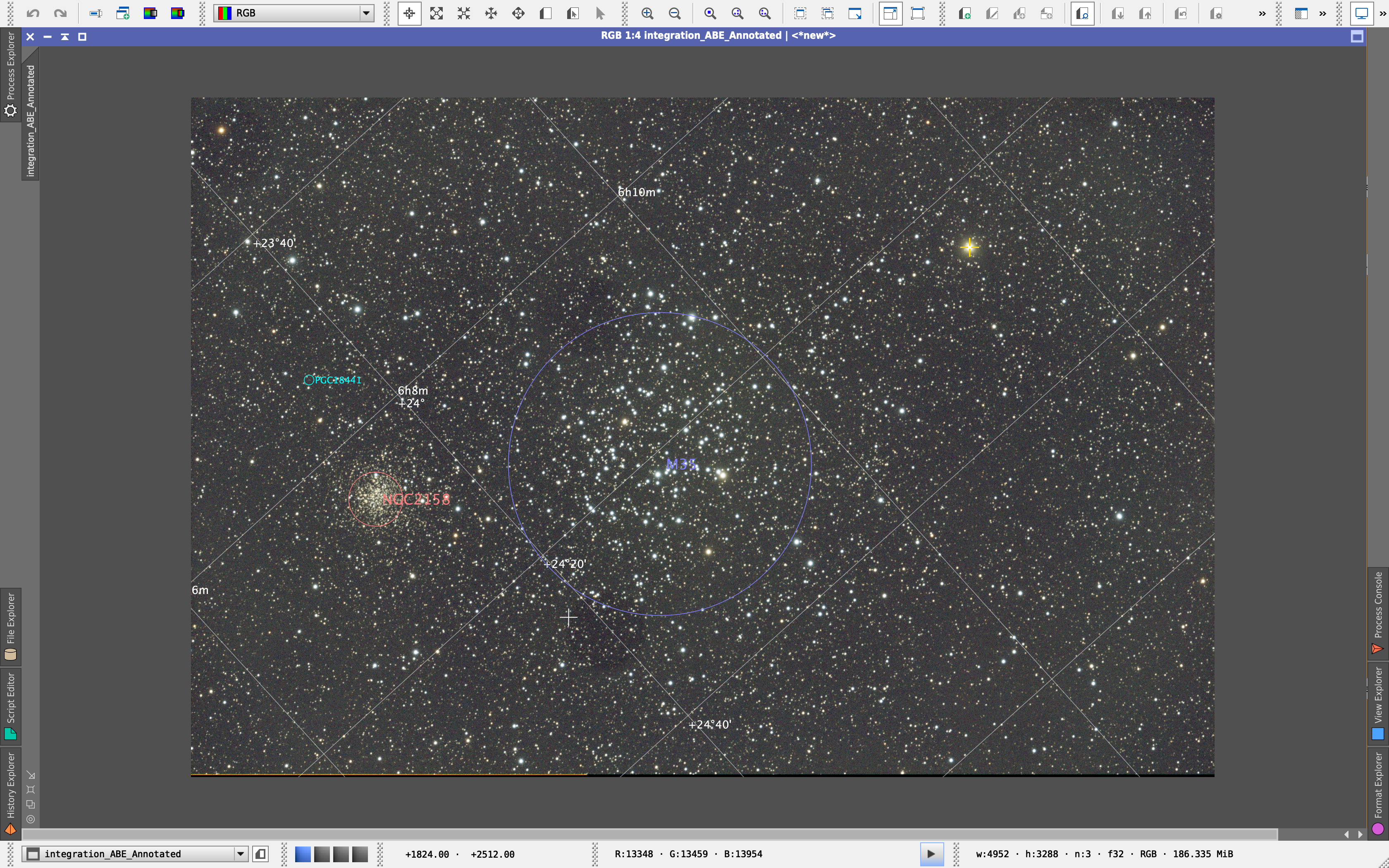
@23:00 finished capturing M35 now waiting for M65 Trio in Leo to go across the meridian

@23:46 started imaging Trio in Leo although there is some high level cloud

MUST REMEMBER TO TAKE FLATS TOMORROW!
Bob had noticed a lot of dirt on or near the sensor on the QHY168C camera that forms part of the imaging train on the Tak FS102. Today I took the camera off for a little spring clean.
The first thing was to mark the rotation angle of the camera so that it goes back on exactly. 21 degrees is the rotation angle as measured through an actual image.

Next I took the camera off loosing the 3 screws holding it in position and then took a look at the CMOS chop glass cover for dirt.
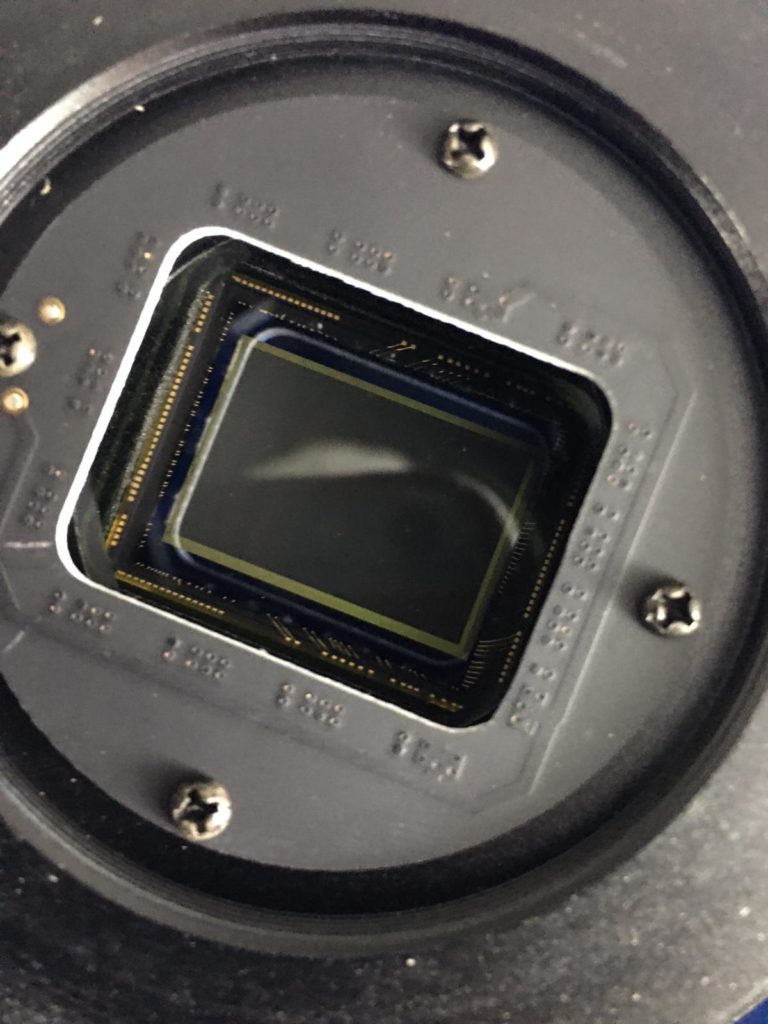
There was really only a couple of pieces of dirt on the cover so I removed them with the blower.

Next I took off the extension tube with which has the glass UV lens inside. At this point I forgot to mark up the position angle when I took the extension tube off. So when I reattached I look at the image train photo to adjust. Hopefully it will be very close and will only require minor adjustment.

Looking at the UV filter it was instantly visible that there was plenty of dirt and dirt on the glass lens, however it transpired to be on the inside of the lens toward the OTA. O removed the filter to clean with the rocket blower.

I then reattached the filter, the camera and reset the angle. I followed up by feeling for any play in the Tak OTA bracket that piggy backs it on the OS12″ OTA. I could not feel any. I was checking due to a shift on the FoV when Bob was recently imaging. Again the next time out we will need to readjust.

Viewing time period – 19:37 – 22:35
Back out again tonight for a short period to look at guiding again. So with everything setup and a longer USB 2 cable in use I am now sitting in the warm Orangery. I will try again with the PHD2 software to guide and EzCap to acquire images from the QHY168C. I have set the Gain to 7 and Offset to 30 as previously used on my other QHY168C when used in Tenerife.
I polar aligned using PoleMaster. Then set about syncing the scope with Betelgeuse. It was only off slightly. The sync worked fine tonight. I then slewed to M35 and started the PHD2 guider software, selected a guide star and calibrated the guider. This worked well first time proving my new step size of 4 using a small ms time for the pulse worked.
Then I started guiding and very quickly realised the same problem as yesterday with DEC drift upwards. No amount of fiddling with the setting such as Hysteresis or Aggressiveness changes the constant upwards drift. I then remembered that I could calibrate the settings as the other night under Guider Assistant. I ran this made the changes but still the upward drift.
I then remembered that on the Paramount MEII in the dome I had to drift align with PHD2 to get it properly polar aligned and that PoleMaster was only good enough for short exposures or rough guiding. So I set about drift aligning.

The first thing to note is that the polar alignment was out by a fair bit to get the accuracy I require in both azimuth and altitude. I have now adjusted both and the graph seems a lot smoother.
So in all it took me around 1 hour to drift align and just as I was about to test the clouds rolled in!

Viewing time period – 19:30 – 23:00
Tonight I wanted to continue to try and get guiding working, I setup outside on a much calmer night, no real wind tonight. Bob once again is playing with the IMT3.
I setup in the same place on the patio and again fed the USB cable through the window. I used the Polemaster to get the mount in the right position and then slewed to Betelgeuse to see if it was in the centre and it was!
I then slewed to M35 and connected the guider with PHD2. After some back and forth I got it calibrated but it was complaining about the amount of steps being to small for calibration and the guiding was all over the place. The screen brightness was still very white. I solved this by changing the Gain for the camera.
I decided to give TheSky X a go at guiding instead of PHD2. Unfortunatly it was not much better and at one point I could see the downloaded image from the guider then suddenly it disappeared, I had changed nothing but now it was black. Nothing I could do would make it come back including disconnecting. So I went back to PHD2.
I managed to fix the issue in PHD on the amount of Steps being used to calibrate by adjusting the calibration step size down from 5333 to 1300. This increased the steps from 3 to 5. Much better and now I don’t get the error.

However right now I still cannot get the Dec to behave. Whilst I can take a 5 min image the Dec is wonder up from where it should be and no amount of tweaking the Aggressiveness or Hysteresis changes that.
Furthermore, I decided to take images with The Sky X over EzCap but after 4 images TSX hangs every time……. So I have now given up tonight and will come back out the next cleanser night to resolve the issues.

Viewing time period – 17:35 – 23:00
First time out for a very long time with the travel setup. I need to get the guiding working before the Tenerife holiday in July. I have left Bob to play with the IMT3 whilst I work through the bugs.
The challenge is at first remembering how to set everything up. I found after some effort I was actually missing a cable, it was in the black wheelie case in the garage with the laptop tent and scope daytime cover, but more about that later.
So So after finding a place on the patio where I could feed the USB cable through the Orangery window, I put the Berlebach tripod down and placed the MyT mount on top. I tightened the screws and then placed the Sky-Watcher Esprit 120 ED on top of the Versa Plate. Once in position I balanced the scope then connected the various cables, now all through the mount due to my good friend Bob making up some power connectors for me.
So I tried to guide through PHD2. There was a large wind blowing. On trying to calibrate the scope would not move. After what seemed like an hour I remembered that cable, this was again the ST4 guider cable that is needed on the Mac if you are guiding with PHD2 as there is no ASCOM. So I connected the ST4 cable and it worked.
What I could not achieve tonight was to get the guide graph behaving, it was a mess. The wind was at fault but still there were other issues, not least the slider to control the contrast of the screen was causing anything above 0.5s to become white.

After many hours I gave up and brought the rig in. I had been using TheSkyX to slew there scope, PHD2 to guide and EzCap to connect to the QHY168C camera and take images. I will try again tomorrow night.
